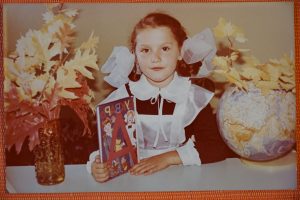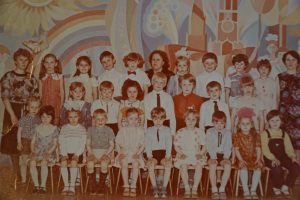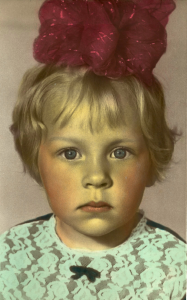Changing media stories of the Cold War era
Year 2019 is the 30th anniversary of the fall of the Berlin Wall, representing the downfall of socialism.
In the international media since 1989, many stories have emerged describing former socialist regimes. Early on, these stories labelled socialist states as repressive and totalitarian and people who lived there as unable to act on their free will. By the 20th anniversary in 2009, the US media reported that the East–West divide was fading, and the former ‘other’ had become part of ‘us’ (Li & Lee, 2013).
Meanwhile Chancellor Angela Merkel has pronounced that “we can change things for the better,” implying that former East Germany should become the same as the former West. A prominent German magazine Der Spiegel announced in 2013 that East German identity is rapidly disappearing and that “East Germany is almost completely gone,” referring to its subsumption by West German standards and the gradual elimination of socio-economic, political and identity divides that distinguished East/Eastern Germany for many years following the reunification.
29 years on, the post-socialist period was re-evaluated as an imposition, arguing that the regimes’ histories were written by the Cold War victors. To mention just one example, the “third generation” of the former East Germans united into a network of scholars and activists and have recently started to document the actual experiences of life under the DDR regime. By troubling and disconnecting from simplified public representations of the “surveillance state” in East Germany by the mainstream media, these stories recognize the complexity, diversity and particularity of individual experiences. It seems that by the 30th anniversary, the media, as well as public and scientific discourses on socialism are ready for an overall reappraisal.
Childhood and the reappraisal of everyday life in socialist regimes
Recognizing the urgent need and a growing interest to explore the lived experiences of socialist and post-socialist socialist societies drives our research on the memories of childhood in socialist and post-socialist societies.
Childhood has been an exceptionally important period of life for socialist regimes. It was closely connected to the realization of its utopian ideal and the socialization of a new generation. By exploring childhoods as remembered, we hope to re-evaluate histories and public representations of socialist regimes. Our questions are: How have childhoods been variously experienced in socialist countries? What insights can we gain about these societies by critically exploring childhood memories?
The first phase of our research project has culminated with the publication of the book Childhood and Schooling in (Post)Socialist Societies: Memories of Everyday Life and a special journal issue “Revisiting Pasts, Reimagining Futures: Memories of (Post)Socialist Childhood and Schooling.” We have just launched the next stage of our collaborative research with the Reconnect / Recollect project funded by KONE Foundation. As a glimpse into the broader project, we would like to introduce a chapter from our book on girls’ bows – a ribbon in girls’ hair with a great symbolic appeal – as an example of how memories of children’s mundane lives can provide new insights into a historical regime.
Hair bows, politics and children’s everyday life
Research on political socialization views children as receptacles of political norms, values, and behaviors acceptable and desirable in a political system. In socialist societies, political socialization took explicit forms and children participated in adult-initiated political processes, such as pioneer organizations or summer labor camps. Positioning children as passive objects – similarly to initial reports on ‘transition’ after socialism –, this view failed to consider children’s subjectivity, agency, and the politics of everyday life.
Bows became a symbol of the idealized Soviet childhood, projecting the images of national prosperity, progress, and happiness.
In our chapter on hair bows, we focused on those spaces of children’s everyday life that usually fall outside of ‘official’ political spheres in which children have their own positions and roles. We focused on the ribbons in girls’ hair called bantiki in Russian, bante in Latvian, and masni in Hungarian (see Fig. 1). We used our memories to disentangle when and how our actions of tying and wearing (or not) the bows fused with the politics of everyday life. Our aim was to show how these banal objects—hair bows—as well as the discourses and practices associated with them, afforded potentialities for our political subjectivities to unfold. In addition, the focus on the bows enabled us to reveal the manifold ways in which an everyday object and practice can become differently political in various geopolitical and personal settings. This view diversifies the singular reading of historical socialism as oppressive.

Figure 1. First day of school with hair bow
We recounted personal memories of everyday childhoods through collective biography (Davies & Gannon, 2006), where memory stories and their interpretations are produced in the intersubjective spaces of participants and in the interrelations between participants’ presents and pasts (and futures). We therefore cannot and do not claim the position of the neutral observer of our lived experiences nor do we aim to recount a historical truth. Rather, we wish to give an account of our existence as ‘schoolgirls’ in socialist societies. By engaging in a collective biography, we strive “to know differently, through … [our] own remembered past and the past of others” (Davies, 2000, p. 187 cited in Davies & Gannon, 2006, p. 33)
Commonly found across the Soviet republics (although less so in the socialist countries of Eastern and Central Europe), bows became a symbol of the idealized Soviet childhood, projecting the images of national prosperity, progress, and happiness. When America’s youngest goodwill ambassador, a ten-year old Samantha Smith, visited the Soviet Union in the early 1980s at the invitation of Yuri Andropov, hair bows were used by the Soviet media to distinguish a Soviet child from an American one. Hair bows were omnipresent: “model girls in posters, magazine photographs, and paintings always had their bantiki” (Kelly, 2007, p. 379). They also appeared in children’s books, poems, movies, and even on wall murals inside school and preschool buildings (see photo in Fig. 2).

Figure 2.
Kindergarten group photo, see girls with bows and painting with girl with bow.
Although the bow appeared differently and played different roles in our memory stories, it was a part of our everyday life. Girls either wore bows or not; but when they did not wear them, they often felt their absence, so bows shaped their experiences:
Bows were a part of the school attire, similar to aprons, collars, and cuffs that had to be sewn onto the dresses, but not necessarily a part of a dress for other social occasions. Playing with friends after school required no bows; family celebrations, similarly, did not require one to wear bows. But even for family celebrations or school parties, loose hair, especially hair longer than shoulder-length not constrained by bows, pins, or pigtails, was rarely allowed—one had to request parents’ permission to wear hair down. As the girl’s grandmother once asked: ‘What would you have without a bow? Just the head’.
We recognized these differences in appearance and subjected ourselves to the norms expected in various social situations. In this way, we became involved in the reproduction of official representations. The bow was an ornament to carry symbolic meanings which we learned to perform in practice. As A. Yurchak (1997) explains, “whether or not one consciously believed in the officially proclaimed goals was less important than the act of participating in routine official practices, perceived as inevitable” (p. 168). When needed, together with carers and teachers, we aligned ourselves with how socialist schoolgirls should look and act even though we did not believe in or could not identify with the official ideology behind it:
For the official school pictures, a girl had to wear three white items: white bow(s), white apron, and white stockings. If one of the items was missing, this girl would either have to stand in the back row or someone else from another class would lend her the missing item(s). Teachers did not get upset when this happened, but simply tried to calmly deal with the situation.
One day, there was a picture session at preschool. The girl’s parents were not present at the time when the pictures were taken because they were working. The preschool nurse was assisting the teacher with preparing children for the pictures and, when she looked at the girl, she sympathetically exclaimed, “Poor little girl! You don’t even have a puffy bow! I will make you look as beautiful as all the other girls. I will make a big bow just for you!” She took off her big gauze scarf and miraculously turned it into a big purple bow. The girl was so happy inside, but also so shocked to suddenly find a big puffy bow towering on top of her head. She did not know what to think, but she went with the flow.

Figure 3. Girl without bow

Figure 4. Girl with huge bow
The bow subjected us to particular forms, norms, and practices of school appearance and order. We resembled and felt like “a normal subject, who saw the truth behind the mask, had no other choice but to pretend that the mask was the actual true face” (Yurchak, 1997, p. 180):
When she looks at the family photographs taken outside of school, she sees a smiling girl with two braids, wearing the clothes brought by a family member from another socialist country, and having no resemblance to the photos taken in school. She has no recollection of any moment when her mom would tie in the bows, and no recollection of any feelings or bodily sensations associated with bows. All that she sees in front of her eyes are the school pictures of her that don’t look like her. She remembers feeling uncomfortable looking at these pictures as a child—as if she was not looking at the real her in the pictures.
Feeling as not real was part of a double pretense, as the socialist state itself was a pretense and we ourselves pretended to be socialist citizens. As the story about the gauze bow continues: That day, the photographer took two pictures of the girl—one as expected by her parents (see photo in Fig. 3) and one as recommended by the preschool (see photo in Fig. 4). Perhaps the official photo day required only one photo with the bow, but two pictures were taken that day. The possibility of two photos, with and without the bow, occurred as a displacement in the discursive regime. In this in-between space, the possibility of a child generated politics emerged.
The story about the gauze bow continues with a marked politics on the parents’ part after they saw that two pictures of their daughter were taken that day:
The girl realized later that her parents were not particularly fond of big puffy bows. “Bows are for the Russian kids,” her Oma (grandmother) would say. And she was from a linguistically and ethnically mixed Latvian/Russian family. When her parents received the pictures a few weeks later, they were shocked. Her dad was particularly unhappy, threatening to go to the preschool and face the director with a complaint. The girl remembers begging him not to do it and saying, “It’s ok, Daddy … it’s just a bow. I look like all the other girls now … Please don’t say anything to the preschool director!” The scandalous nature of the bow incident remained deep in her heart, leaving a feeling of guilt and bewilderment … as well as a picture proof of how confused she looked wearing the big puffy bow on top of her head in the official photograph.
Here, the bow marked a feeling of national belonging for the girl’s parents and wearing (or not) the bow became part of everyday politics of ignoring official prescriptions. For us children, appearances were just what they were—only appearances. And that is how we learned to relate to them. Just as adults pretended to follow the ideology on the surface, be present physically but not emotionally or cognitively, we too knew that it sufficed to look as expected, without embodying the ideals through and through. This behavior implied neither active resistance nor subversion, but rather active ignorance, or perhaps the creative reinterpretation of situations. Just as a grandma remarked on a question about the role of bows—“They just were there.”
This ambiguous relationship with the system is well captured in Yurchak’s (1997) notion of “pretense misrecognition”. These kinds of political acts were not laden with the ridicule of or resistance to power, but rather with a lack of interest in it (Yurchak, 1997, pp. 162–163, our emphasis). In this manner, political pretense and ignorance were learned as part of our mundane schooling. While politics is commonly associated with the existence of interests in agendas related to groups, here “the lack of interest” and the discomfort that was associated with the reiterative practices of being different kinds of schoolgirls in various spaces created opportunities for childhood politics in mundane, day-to-day life.
Children reinterpreting official politics
With our actions and understandings about the bow, we have interpreted official representations and ideologies in our own ways and on our own terms. With our mundane acts, we silently joined others in showing no interest in the official ideology, and/or pretended to misrecognize it, or were casted by others in small oppositional acts to official expectations. We learned to read spaces and discursive formations attached to schools, classrooms, assembly halls, or homes that govern action, thought, and feeling and that were politically charged with official ideology or gained their charge through people’s everyday participation in it.
According to Yurchak (2006), the “non-official” was not only something that allowed spaces for resistance against the dominant political ideology but also maintained the system as such. In a similar manner, actions against stated ideology manifested in a form of outward resistance against official politics and included actions that were differently political, such as those of humor or pretense. Within these complicated political arenas, we understood ourselves as children or schooled subjects, and subjected ourselves to the operating discourses. Different spaces afforded us with shifting reiterations, (in)actions, and feelings that made us explore operative discourses and subject positions. They also produced opportunities for us to act politically, joining the collective struggle to gain power over immediate conditions of existence. The experiences of being and acting in this way thus bring into question interpretations of socialist citizens as passive and uncritically following rules.
Our memory stories do not only talk about the past. They also became fertile grounds for our contemporary understandings of politics, political agency, and subject formation that needs further investigation. Offering a rich resource, our memories of childhood complicate simple understandings of what it meant to be a child during the Cold War.
References:
Davies, B., & Gannon, S. (2006). Doing collective biography: Investigating the production of subjectivity. Maidenhead: Open University Press.
Li, H., & Lee, C.-C. (2013). Remembering Tiananmen and the Berlin Wall: the elite U.S. press’s anniversary journalism, 1990–2009. Media, Culture & Society, 35(7), 830–846.
Kelly, C. (2007). Children’s world: Growing up in Russia, 1890–1991. New Haven, CT: Yale University.
Yurchak, A. (1997). The cynical reason of late socialism: power, pretense and the anekdot. Public Culture, 9, 161-188.
Yurchak, A. (2006). Everything was forever until it was no more: The last Soviet generation. Princeton, NJ: Princeton University Press.







